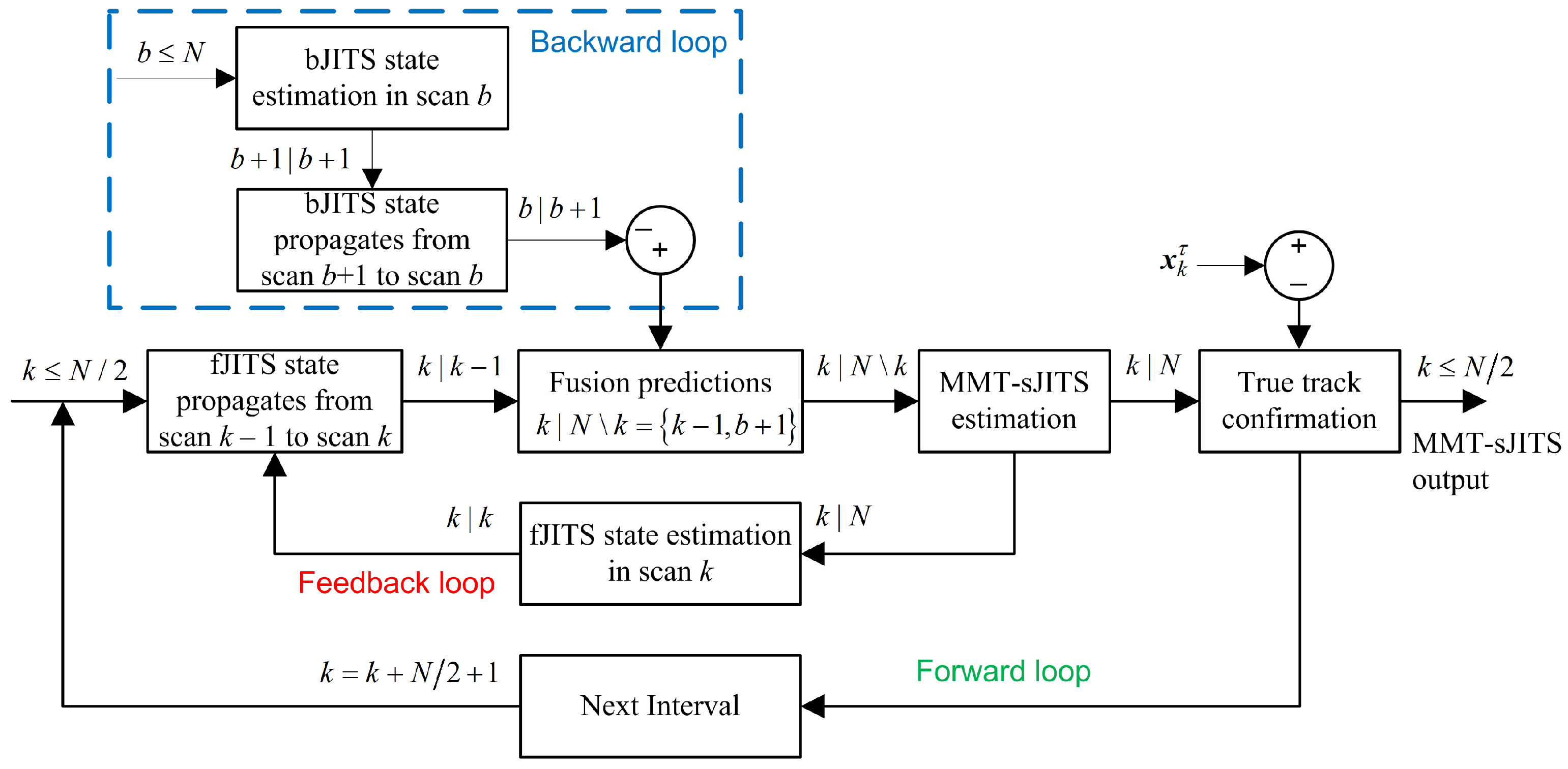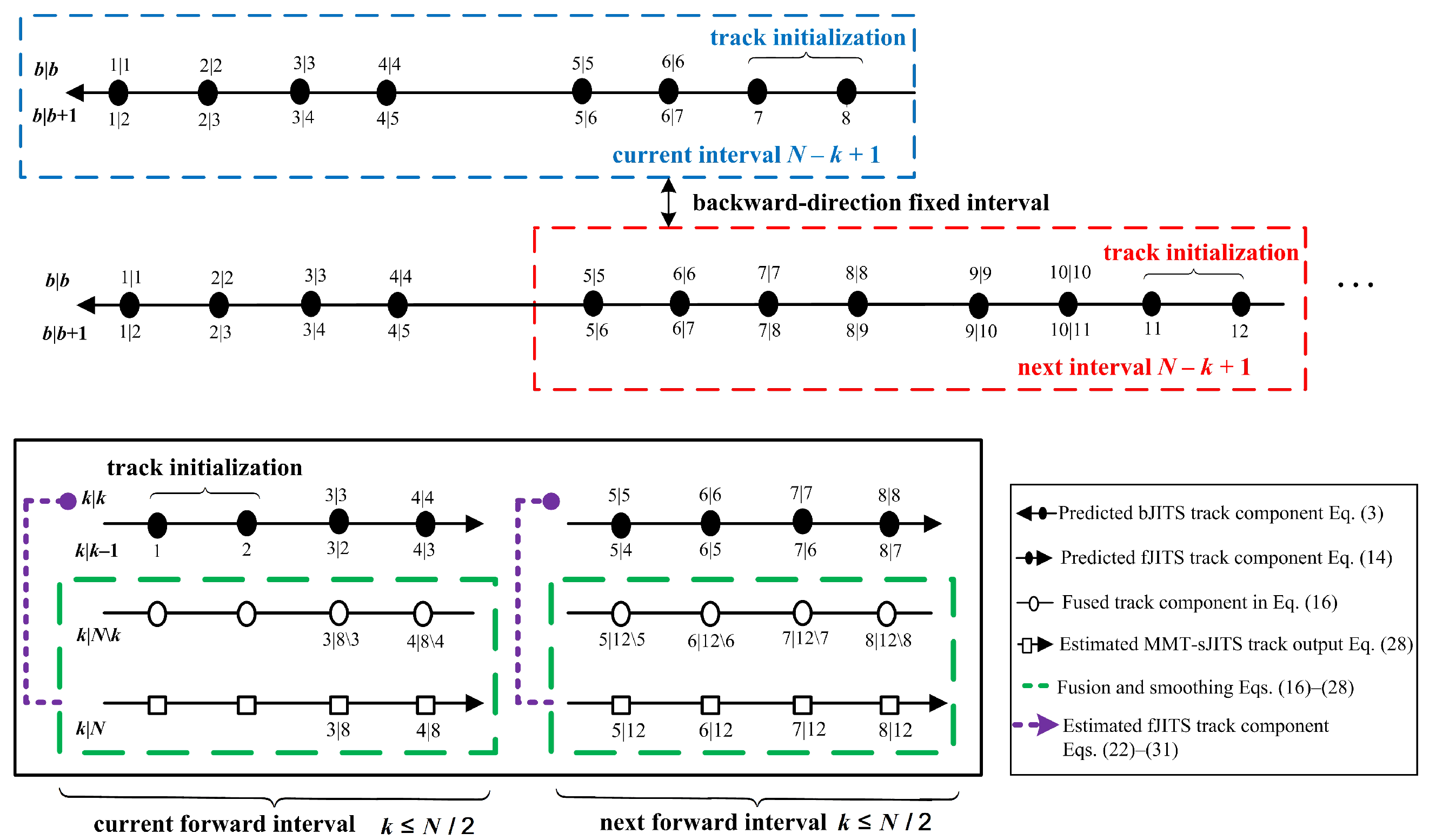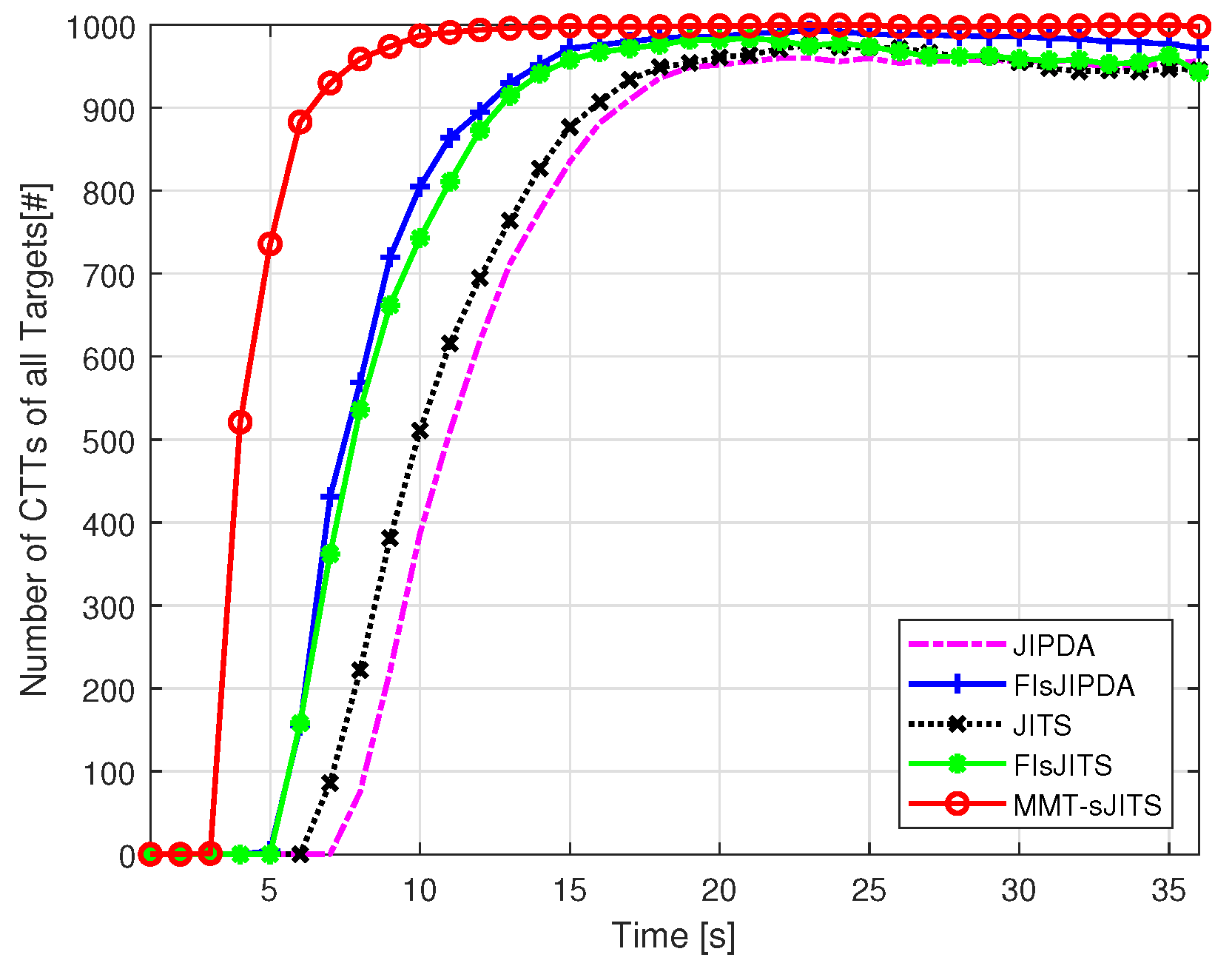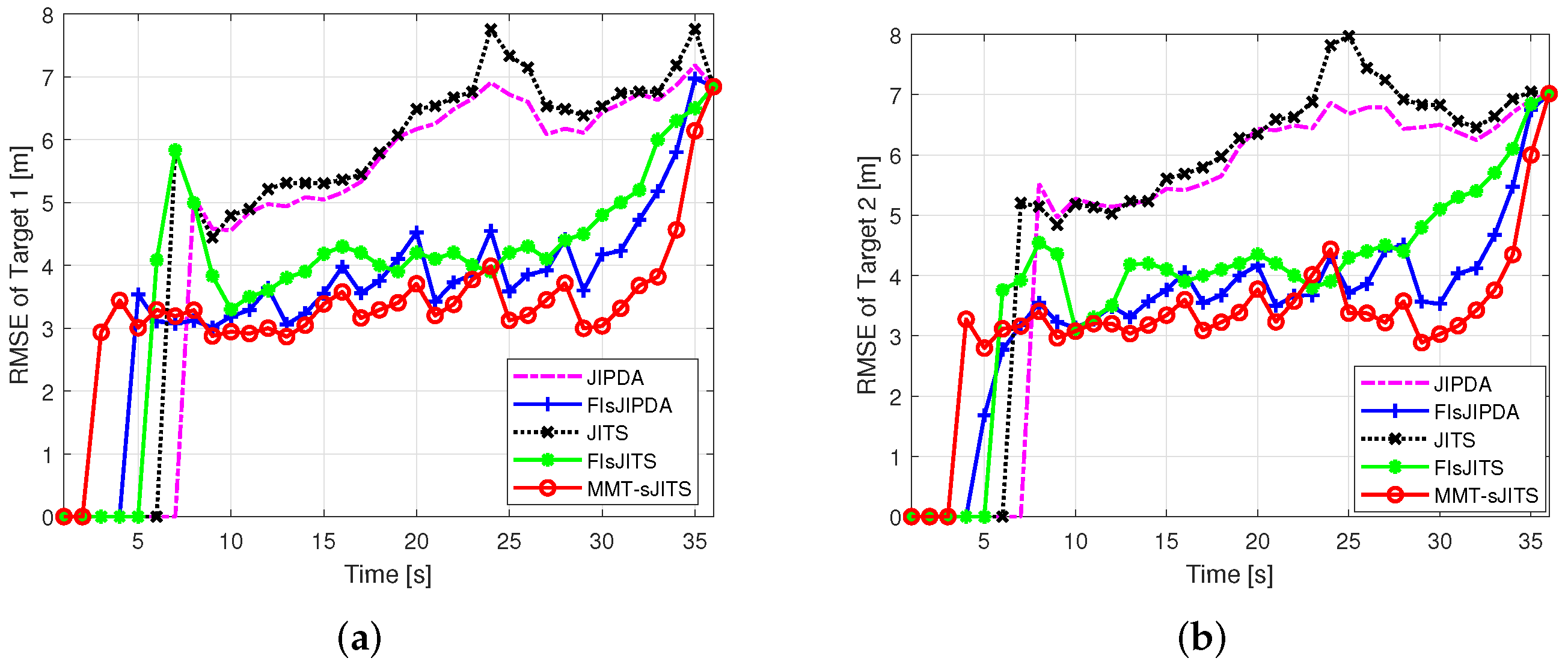Modified Smoothing Algorithm for Tracking Multiple Maneuvering Targets in Clutter
Abstract
:1. Introduction
2. Target Trajectory Model
3. Smoothing Joint Integrated Track Splitting Algorithm
- : b denotes the backward scan index and N denotes the last scan index of the fixed interval ;
- denotes the current scan and current scan measurement in a backward direction; for example, (where, superscript denotes the track component and an accentˆ(hat) indicates a state estimate) is the backward state estimate obtained in scan conditioning on the measurements set ;
- denotes the next scan time b, but conditioned on the previous backward scan ; for example, (where, an accent¯(bar) indicates a state prediction) is the backward state prediction obtained based on the measurements set and propagated to the next scan b;
- denotes the next scan k in forward direction but conditioned on the previous scan ; for example, is the forward state prediction obtained in previous scan based on the previous scan measurements set , which now propagated to the next scan k;
- denotes a current forward scan and conditioning on the last scan measurements set up to , and not including measurements set of scan , which is used to show the fusion of forward and backward multi-tracks (e.g., is the fused priori smoothing state prediction in scan k, conditioned on excluding );
- denotes the current scan in a forward direction, conditional on the last scan measurements set up to current scan measurements set ; for example, is the smoother state estimate obtained in scan k conditioning on the measurements set up to , including the measurements set ;
- denotes the current scan and conditioning on current scan measurements set in a forward direction; for example, is the forward state estimate obtained in scan k conditioning on the measurements set ;
- indicates that the smoothing state statistics is evaluated for up to half of the fixed interval , so that the next overlapped fixed interval can be processed starting from scan .
3.1. Backward Joint Integrated Track Splitting (bJITS)
3.2. Forward Joint Integrated Track Splitting (fJITS)
3.3. MMT-sJITS Smoothing Track Update
3.4. Implementation of the MMT-sJITS Algorithm
- bJITS procedure is illustrated in the blue rectangular frame showing the iteration from the first fixed interval. bJITS multi-track state component estimation and prediction are computed recursively in each scan starting from the to scan, followed by Equations (3)–(14). The indices of backward scans and conditioning on the measurements (both old and new conditioned observation data) are described in Section 3 (see Figure 1). For example, is a state component estimate and is a state component prediction. Note that the last two scans (i.e., and N) are used to initialize backward tracks (two-point initialization approach [2]) in every interval.
- MMT-sJITS multi-track smoothing state estimate is obtained in scan k conditioning on , which indicates that the state is updated based on all measurements collected up to the scan, including the current scan k (e.g., ). Consequently, the validated smoothing measurements are applied to the fJITS via feedback loop to calculate the forward multi-track state estimation in each scan using Equations (16)–(32). Here, is state estimation conditioning on and on scan k which is propagated using Equation (15) to obtain the state component prediction in scan conditioning on , such as, . is a state prediction obtained in scan conditioning on scan and on using the track initialization process.
4. MMT-sJITS Analysis Using Simulation
4.1. Track Component Management
4.2. False Track Discrimination (FTD)
- Confirmed true tracks (CTTs): To achieve a CTT, a confimed track must satisfy Equation (33) with . The CTTs stay in the same status until their normalized distance squared value (expressed by parenthesis term in above Equation) goes ahead of the maximum threshold limit; that is, .
- Confirmed false track (CFTs): With , a confirmed track becomes a CFT. It is also possible CFT becomes a CTT and vice versa. The value of is not fixed and can be used differently, which depends on the situation of the surveillance scenarios and requirements.
4.3. Output Statistics Analysis
- Case: a number of CTTs followed by a target in scan ;
- Okay: a number of CTTs pursued the same target in scan ;
- Swapped: a number of CTTs exchanged by some other target CTT in scan 30;
- Lost: a number of CTTs in scan 30 lost due to either track deletion because of the low target existence or low component existence probabilities, or they became CFTs;
- Result: a number of CTTs in the final scan .
- Execution time [s]: the average calculation time per each Monte Carlo Simulation run that was analyzed using the MatLab R2020b software on the platform, 11th Intel Core™i7-1165G7 (@ 2.80 GHz, 2.80 GHz).
5. Conclusions
Author Contributions
Funding
Institutional Review Board Statement
Informed Consent Statement
Data Availability Statement
Acknowledgments
Conflicts of Interest
References
- Baum, M.; Hanebeck, U.D. Extended object tracking with random hypersurface models. IEEE Trans. Aerosp. Electron. Syst. 2014, 15, 149–159. [Google Scholar] [CrossRef] [Green Version]
- Challa, S.; Evans, R.; Morelande, M.; Mušicki, D. Fundamentals of Object Tracking; Cambridge University Press: New York, NY, USA, 2011. [Google Scholar]
- Mušicki, D.; Evans, R. Integrated probabilistic data association-finite resolution. Automatica 1995, 31, 559–570. [Google Scholar] [CrossRef]
- Chen, X.; Li, Y.; Li, J.; Li, X. A Novel Probabilistic Data Association for Target Tracking in a Cluttered Environment. Sensors 2016, 16, 2180. [Google Scholar] [CrossRef] [PubMed] [Green Version]
- He, S.; Shin, H.S.; Tsourdos, A. Joint Probabilistic Data Association Filter with Unknown Detection Probability and Clutter Rate. Sensors 2018, 18, 269. [Google Scholar] [CrossRef] [Green Version]
- Mušicki, D.; Evans, R. JIPDA: Automatic target tracking avoiding track coalescence. IEEE Trans. Aerosp. Electron. Syst. 2015, 51, 962–974. [Google Scholar]
- Song, T.L.; Mušicki, D.; Yong, K. Multi-target tracking with state dependent detection. IET Radar Sonar Navig. 2015, 9, 10–18. [Google Scholar] [CrossRef]
- Song, T.L.; Mušicki, D. Target tracking with target state dependent detection. IEEE Trans. Signal Process. 2011, 59, 1063–1074. [Google Scholar] [CrossRef]
- Sathyan, T.; Chin, T.; Arulampalam, S.; Suter, D. A Multiple Hypothesis Tracker for Multitarget Tracking with Multiple Simultaneous Measurements. IEEE J. Sel. Top. Signal Process. 2013, 7, 448–460. [Google Scholar] [CrossRef]
- Mušicki, D.; Song, T.L.; Lee, H. Linear multitarget finite resolution tracking in clutter. IEEE Trans. Aerosp. Electron. Syst. 2014, 50, 1798–1812. [Google Scholar] [CrossRef]
- Shin, M.; Son, H. Multiple Sensor Linear Multi-Target Integrated Probabilistic Data Association for Ultra-Wide Band Radar. IEEE Access 2020, 8, 227161–227171. [Google Scholar] [CrossRef]
- Huang, Y.; Song, T.L. Linear multitarget integrated track splitting for multiple detection target tracking. In Proceedings of the 2017 International Conference on Control, Automation and Information Sciences (ICCAIS), Chiang Mai, Thailand, 31 October– 1 November 2017; pp. 79–85. [Google Scholar]
- Simon, D. Optimal State Estimation; John Wiley and Sons, Inc.: New York, NY, USA, 2006. [Google Scholar]
- Jason, S.; Travis, B.; Mark, R.; Jason, B.; Moriba, J.; Keric, H. Joint Probabilistic Data Association and Smoothing Applied to Multiple Space Object Tracking. J. Guid. Control Dyn. 2017, 41, 1–15. [Google Scholar]
- Koch, W. Fixed-interval retrodiction approach to Bayesian IMM-MHT for maneuvering multiple targets. IEEE Trans. Aerosp. Electron. Syst. 2000, 36, 2–14. [Google Scholar] [CrossRef]
- Nagappa, S.; Delande, E.D.; Clark, D.E.; Houssineau, J. A Tractable Forward– Backward CPHD Smoother. IEEE Trans. Aeorsp. Electron. Sys. 2017, 53, 201–217. [Google Scholar] [CrossRef]
- Memon, S.A.; Kim, M.; Son, H. Tracking and Estimation of Multiple Cross-over Targets in Clutter. Sensors 2019, 19, 741. [Google Scholar] [CrossRef] [Green Version]
- Memon, S.A.; Kim, M.; Shin, M.; Daudpoto, J.; Pathan, D.M.; Son, H. Extended Smoothing Joint Data Association for Multi-target Tracking in Cluttered Environments. IET Radar Sonar Navig. 2020, 14, 564–571. [Google Scholar] [CrossRef]
- Kim, T.H.; Mušicki, D.; Song, T.L.; Lee, C.M. Smoothing joint integrated probabilistic data association. IET Radar Sonar Navig. 2015, 9, 62–66. [Google Scholar] [CrossRef]
- Kim, T.H.; Song, T.L. Multi-target multi-scan smoothing in clutter. IET Radar Sonar Navig. 2016, 10, 1270–1276. [Google Scholar] [CrossRef]
- Zhu, W.; Wang, W.; Yuan, G. An Improved Interacting Multiple Model Filtering Algorithm Based on the Cubature Kalman Filter for Maneuvering Target Tracking. Sensors 2016, 16, 805. [Google Scholar] [CrossRef] [Green Version]
- Kim, M.; Memon, S.A.; Shin, M.; Son, H. Dynamic based trajectory estimation and tracking in an uncertain environment. Expert Syst. Appl. 2021, 177, 114919. [Google Scholar] [CrossRef]
- Song, T.L.; Musicki, D. Adaptive clutter measurement density estimation for improved target tracking. IEEE Trans. Aerosp. Electron. Syst. 2011, 47, 1457–1466. [Google Scholar] [CrossRef]
- Grewal, M.S.; Andrews, A.P. Kalman Filtering: Theory and Practice with MATLAB; John Wiley and Sons: New York, NY, USA, 2014. [Google Scholar]
- Memon, S.; Song, T.L.; Kim, T.H. Smoothing Data Association for Target Trajectory Estimation in Cluttered Environments. Eurasip J. Adv. Signal Process. 2016, 21, 1–21. [Google Scholar] [CrossRef] [Green Version]
- Memon, S.; Son, H.; Memon, K.H.; Ansari, A. Multi-scan smoothing for tracking manoeuvering target trajectory in heavy cluttered environment. IET Radar Sonar Navig. 2017, 11, 1815–1821. [Google Scholar] [CrossRef]
- Blackman, S.; Popoli, R. Design and Analysis of Modern Tracking Systems; Artech House: Boston, MA, USA; London, UK, 1999. [Google Scholar]
- Salmond, D.J. Mixture Reduction Algorithms for Target Tracking in Clutter. In Signal and Data Processing of Small Targets; SPIE: Bellingham, WA, USA, 1990; Volume 1305, pp. 434–445. [Google Scholar]
- Memon, S.A.; Song, T.L.; Memon, K.H.; Ullah, I.; Khan, U. Modified Smoothing Data Association for Target Tracking in Clutter. Expert Syst. Appl. 2020, 141, 112969. [Google Scholar] [CrossRef]
- Jia, B.; Pham, K.; Blasch, E.; Shen, D.; Chen, G. Consensus-based auction algorithm for distributed sensor management in space object tracking. In Proceedings of the 2017 IEEE Aerospace Conference, Big Sky, MT, USA, 4–11 March 2017. [Google Scholar]





| Method | Case | Okay | Swapped | Lost | Result | Execution Time [s] |
|---|---|---|---|---|---|---|
| MMT-sJITS | 998 | 932 | 64 | 2 | 979 | 1.64 |
| FIsJITS | 981 | 893 | 75 | 13 | 970 | 1.72 |
| FIsJIPDA | 986 | 931 | 43 | 12 | 972 | 2.0 |
| JITS | 955 | 897 | 29 | 29 | 946 | 0.7 |
| JIPDA | 956 | 772 | 156 | 28 | 956 | 0.5 |
Publisher’s Note: MDPI stays neutral with regard to jurisdictional claims in published maps and institutional affiliations. |
© 2022 by the authors. Licensee MDPI, Basel, Switzerland. This article is an open access article distributed under the terms and conditions of the Creative Commons Attribution (CC BY) license (https://creativecommons.org/licenses/by/4.0/).
Share and Cite
Memon, S.A.; Park, M.-S.; Memon, I.; Kim, W.-G.; Khan, S.; Shi, Y. Modified Smoothing Algorithm for Tracking Multiple Maneuvering Targets in Clutter. Sensors 2022, 22, 4759. https://doi.org/10.3390/s22134759
Memon SA, Park M-S, Memon I, Kim W-G, Khan S, Shi Y. Modified Smoothing Algorithm for Tracking Multiple Maneuvering Targets in Clutter. Sensors. 2022; 22(13):4759. https://doi.org/10.3390/s22134759
Chicago/Turabian StyleMemon, Sufyan Ali, Min-Seuk Park, Imran Memon, Wan-Gu Kim, Sajid Khan, and Yifang Shi. 2022. "Modified Smoothing Algorithm for Tracking Multiple Maneuvering Targets in Clutter" Sensors 22, no. 13: 4759. https://doi.org/10.3390/s22134759
APA StyleMemon, S. A., Park, M.-S., Memon, I., Kim, W.-G., Khan, S., & Shi, Y. (2022). Modified Smoothing Algorithm for Tracking Multiple Maneuvering Targets in Clutter. Sensors, 22(13), 4759. https://doi.org/10.3390/s22134759






